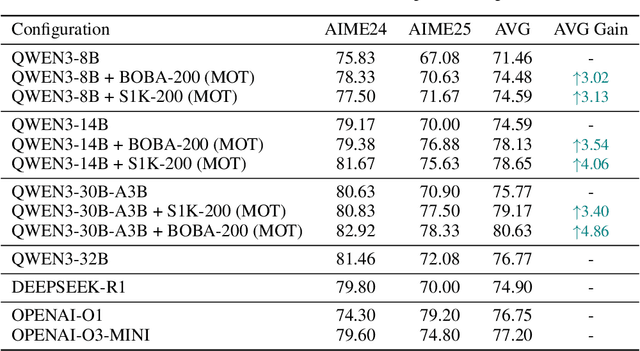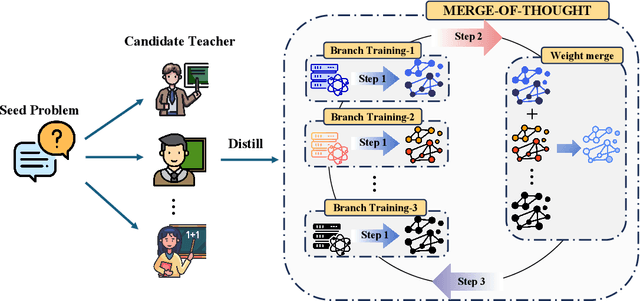Gang Chen
Junbo
Merge-of-Thought Distillation
Sep 10, 2025



Abstract:Efficient reasoning distillation for long chain-of-thought (CoT) models is increasingly constrained by the assumption of a single oracle teacher, despite practical availability of multiple candidate teachers and growing CoT corpora. We revisit teacher selection and observe that different students have different "best teachers," and even for the same student the best teacher can vary across datasets. Therefore, to unify multiple teachers' reasoning abilities into student with overcoming conflicts among various teachers' supervision, we propose Merge-of-Thought Distillation (MoT), a lightweight framework that alternates between teacher-specific supervised fine-tuning branches and weight-space merging of the resulting student variants. On competition math benchmarks, using only about 200 high-quality CoT samples, applying MoT to a Qwen3-14B student surpasses strong models including DEEPSEEK-R1, QWEN3-30B-A3B, QWEN3-32B, and OPENAI-O1, demonstrating substantial gains. Besides, MoT consistently outperforms the best single-teacher distillation and the naive multi-teacher union, raises the performance ceiling while mitigating overfitting, and shows robustness to distribution-shifted and peer-level teachers. Moreover, MoT reduces catastrophic forgetting, improves general reasoning beyond mathematics and even cultivates a better teacher, indicating that consensus-filtered reasoning features transfer broadly. These results position MoT as a simple, scalable route to efficiently distilling long CoT capabilities from diverse teachers into compact students.
SPA++: Generalized Graph Spectral Alignment for Versatile Domain Adaptation
Aug 07, 2025Abstract:Domain Adaptation (DA) aims to transfer knowledge from a labeled source domain to an unlabeled or sparsely labeled target domain under domain shifts. Most prior works focus on capturing the inter-domain transferability but largely overlook rich intra-domain structures, which empirically results in even worse discriminability. To tackle this tradeoff, we propose a generalized graph SPectral Alignment framework, SPA++. Its core is briefly condensed as follows: (1)-by casting the DA problem to graph primitives, it composes a coarse graph alignment mechanism with a novel spectral regularizer toward aligning the domain graphs in eigenspaces; (2)-we further develop a fine-grained neighbor-aware propagation mechanism for enhanced discriminability in the target domain; (3)-by incorporating data augmentation and consistency regularization, SPA++ can adapt to complex scenarios including most DA settings and even challenging distribution scenarios. Furthermore, we also provide theoretical analysis to support our method, including the generalization bound of graph-based DA and the role of spectral alignment and smoothing consistency. Extensive experiments on benchmark datasets demonstrate that SPA++ consistently outperforms existing cutting-edge methods, achieving superior robustness and adaptability across various challenging adaptation scenarios.
WGRAMMAR: Leverage Prior Knowledge to Accelerate Structured Decoding
Jul 22, 2025Abstract:Structured decoding enables large language models (LLMs) to generate outputs in formats required by downstream systems, such as HTML or JSON. However, existing methods suffer from efficiency bottlenecks due to grammar compilation, state tracking, and mask creation. We observe that many real-world tasks embed strong prior knowledge about output structure. Leveraging this, we propose a decomposition of constraints into static and dynamic components -- precompiling static structures offline and instantiating dynamic arguments at runtime using grammar snippets. Instead of relying on pushdown automata, we employ a compositional set of operators to model regular formats, achieving lower transition latency. We introduce wgrammar, a lightweight decoding engine that integrates domain-aware simplification, constraint decomposition, and mask caching, achieving up to 250x speedup over existing systems. wgrammar's source code is publicly available at https://github.com/wrran/wgrammar.
Baltimore Atlas: FreqWeaver Adapter for Semi-supervised Ultra-high Spatial Resolution Land Cover Classification
Jun 18, 2025Abstract:Ultra-high Spatial Resolution Land Cover Classification is essential for fine-grained land cover analysis, yet it remains challenging due to the high cost of pixel-level annotations, significant scale variation, and the limited adaptability of large-scale vision models. Existing methods typically focus on 1-meter spatial resolution imagery and rely heavily on annotated data, whereas practical applications often require processing higher-resolution imagery under weak supervision. To address this, we propose a parameter-efficient semi-supervised segmentation framework for 0.3 m spatial resolution imagery, which leverages the knowledge of SAM2 and introduces a remote sensing-specific FreqWeaver Adapter to enhance fine-grained detail modeling while maintaining a lightweight design at only 5.96% of the total model parameters. By effectively leveraging unlabeled data and maintaining minimal parameter overhead, the proposed method delivers robust segmentation results with superior structural consistency, achieving a 1.78% improvement over existing parameter-efficient tuning strategies and a 3.44% gain compared to state-of-the-art high-resolution remote sensing segmentation approaches.
Machine Unlearning for Robust DNNs: Attribution-Guided Partitioning and Neuron Pruning in Noisy Environments
Jun 13, 2025Abstract:Deep neural networks (DNNs) have achieved remarkable success across diverse domains, but their performance can be severely degraded by noisy or corrupted training data. Conventional noise mitigation methods often rely on explicit assumptions about noise distributions or require extensive retraining, which can be impractical for large-scale models. Inspired by the principles of machine unlearning, we propose a novel framework that integrates attribution-guided data partitioning, discriminative neuron pruning, and targeted fine-tuning to mitigate the impact of noisy samples. Our approach employs gradient-based attribution to probabilistically distinguish high-quality examples from potentially corrupted ones without imposing restrictive assumptions on the noise. It then applies regression-based sensitivity analysis to identify and prune neurons that are most vulnerable to noise. Finally, the resulting network is fine-tuned on the high-quality data subset to efficiently recover and enhance its generalization performance. This integrated unlearning-inspired framework provides several advantages over conventional noise-robust learning approaches. Notably, it combines data-level unlearning with model-level adaptation, thereby avoiding the need for full model retraining or explicit noise modeling. We evaluate our method on representative tasks (e.g., CIFAR-10 image classification and speech recognition) under various noise levels and observe substantial gains in both accuracy and efficiency. For example, our framework achieves approximately a 10% absolute accuracy improvement over standard retraining on CIFAR-10 with injected label noise, while reducing retraining time by up to 47% in some settings. These results demonstrate the effectiveness and scalability of the proposed approach for achieving robust generalization in noisy environments.
Using In-Context Learning for Automatic Defect Labelling of Display Manufacturing Data
Jun 05, 2025Abstract:This paper presents an AI-assisted auto-labeling system for display panel defect detection that leverages in-context learning capabilities. We adopt and enhance the SegGPT architecture with several domain-specific training techniques and introduce a scribble-based annotation mechanism to streamline the labeling process. Our two-stage training approach, validated on industrial display panel datasets, demonstrates significant improvements over the baseline model, achieving an average IoU increase of 0.22 and a 14% improvement in recall across multiple product types, while maintaining approximately 60% auto-labeling coverage. Experimental results show that models trained on our auto-labeled data match the performance of those trained on human-labeled data, offering a practical solution for reducing manual annotation efforts in industrial inspection systems.
UI-Evol: Automatic Knowledge Evolving for Computer Use Agents
May 28, 2025Abstract:External knowledge has played a crucial role in the recent development of computer use agents. We identify a critical knowledge-execution gap: retrieved knowledge often fails to translate into effective real-world task execution. Our analysis shows even 90\% correct knowledge yields only 41\% execution success rate. To bridge this gap, we propose UI-Evol, a plug-and-play module for autonomous GUI knowledge evolution. UI-Evol consists of two stages: a Retrace Stage that extracts faithful objective action sequences from actual agent-environment interactions, and a Critique Stage that refines existing knowledge by comparing these sequences against external references. We conduct comprehensive experiments on the OSWorld benchmark with the state-of-the-art Agent S2. Our results demonstrate that UI-Evol not only significantly boosts task performance but also addresses a previously overlooked issue of high behavioral standard deviation in computer use agents, leading to superior performance on computer use tasks and substantially improved agent reliability.
Teaching Large Language Models to Maintain Contextual Faithfulness via Synthetic Tasks and Reinforcement Learning
May 22, 2025Abstract:Teaching large language models (LLMs) to be faithful in the provided context is crucial for building reliable information-seeking systems. Therefore, we propose a systematic framework, CANOE, to improve the faithfulness of LLMs in both short-form and long-form generation tasks without human annotations. Specifically, we first synthesize short-form question-answering (QA) data with four diverse tasks to construct high-quality and easily verifiable training data without human annotation. Also, we propose Dual-GRPO, a rule-based reinforcement learning method that includes three tailored rule-based rewards derived from synthesized short-form QA data, while simultaneously optimizing both short-form and long-form response generation. Notably, Dual-GRPO eliminates the need to manually label preference data to train reward models and avoids over-optimizing short-form generation when relying only on the synthesized short-form QA data. Experimental results show that CANOE greatly improves the faithfulness of LLMs across 11 different downstream tasks, even outperforming the most advanced LLMs, e.g., GPT-4o and OpenAI o1.
GATES: Cost-aware Dynamic Workflow Scheduling via Graph Attention Networks and Evolution Strategy
May 18, 2025Abstract:Cost-aware Dynamic Workflow Scheduling (CADWS) is a key challenge in cloud computing, focusing on devising an effective scheduling policy to efficiently schedule dynamically arriving workflow tasks, represented as Directed Acyclic Graphs (DAG), to suitable virtual machines (VMs). Deep reinforcement learning (DRL) has been widely employed for automated scheduling policy design. However, the performance of DRL is heavily influenced by the design of the problem-tailored policy network and is highly sensitive to hyperparameters and the design of reward feedback. Considering the above-mentioned issues, this study proposes a novel DRL method combining Graph Attention Networks-based policy network and Evolution Strategy, referred to as GATES. The contributions of GATES are summarized as follows: (1) GATES can capture the impact of current task scheduling on subsequent tasks by learning the topological relationships between tasks in a DAG. (2) GATES can learn the importance of each VM to ready tasks, increasing the chance of selecting the optimal VM. (3) Utilizing Evolution Strategy's robustness, exploratory nature, and tolerance for delayed rewards, GATES achieves stable policy learning in CADWS. Extensive experimental results demonstrate the superiority of the proposed GATES in CADWS, outperforming several state-of-the-art algorithms. Codes are available at: https://github.com/YaShen998/GATES
HAKES: Scalable Vector Database for Embedding Search Service
May 18, 2025Abstract:Modern deep learning models capture the semantics of complex data by transforming them into high-dimensional embedding vectors. Emerging applications, such as retrieval-augmented generation, use approximate nearest neighbor (ANN) search in the embedding vector space to find similar data. Existing vector databases provide indexes for efficient ANN searches, with graph-based indexes being the most popular due to their low latency and high recall in real-world high-dimensional datasets. However, these indexes are costly to build, suffer from significant contention under concurrent read-write workloads, and scale poorly to multiple servers. Our goal is to build a vector database that achieves high throughput and high recall under concurrent read-write workloads. To this end, we first propose an ANN index with an explicit two-stage design combining a fast filter stage with highly compressed vectors and a refine stage to ensure recall, and we devise a novel lightweight machine learning technique to fine-tune the index parameters. We introduce an early termination check to dynamically adapt the search process for each query. Next, we add support for writes while maintaining search performance by decoupling the management of the learned parameters. Finally, we design HAKES, a distributed vector database that serves the new index in a disaggregated architecture. We evaluate our index and system against 12 state-of-the-art indexes and three distributed vector databases, using high-dimensional embedding datasets generated by deep learning models. The experimental results show that our index outperforms index baselines in the high recall region and under concurrent read-write workloads. Furthermore, \namesys{} is scalable and achieves up to $16\times$ higher throughputs than the baselines. The HAKES project is open-sourced at https://www.comp.nus.edu.sg/~dbsystem/hakes/.
 Add to Chrome
Add to Chrome Add to Firefox
Add to Firefox Add to Edge
Add to Edge